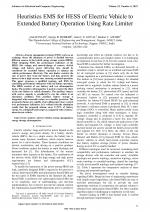| 4/2022 - 2 |
Heuristics EMS for HESS of Electric Vehicle to Extended Battery Operation Using Rate LimiterRANJAN, A. |
| Extra paper information in |
| Click to see author's profile in |
| Download PDF |
Author keywords
battery, electric vehicles, energy management, energy storage, ultracapacitor
References keywords
energy(27), electric(20), power(19), hybrid(17), battery(16), system(15), storage(12), vehicles(11), management(10), vehicle(8)
Blue keywords are present in both the references section and the paper title.
About this article
Date of Publication: 2022-11-30
Volume 22, Issue 4, Year 2022, On page(s): 11 - 22
ISSN: 1582-7445, e-ISSN: 1844-7600
Digital Object Identifier: 10.4316/AECE.2022.04002
Web of Science Accession Number: 000920289700002
SCOPUS ID: 85150165654
Abstract
Energy management strategy (EMS) works as an exchange where the allotment of power is decided between different sources in the hybrid energy storage system (HESS). While designing EMS, the performance indicators of the HESS, like voltage and state-of-charge of sources, dc-link voltage, and battery power delivering rate, should be considered for extended battery operation to enhance the vehicle performance effectively. The rate limiter restricts the rate of power flow from the battery and thus protects the battery from a high current rate, ensuring extended operation. This paper proposes a modified topology and EMS for controlling performance indicators with rate limiter operation. The HESS consists of one battery and two ultracapacitor banks. The auxiliary ultracapacitor is used to counter the effect of the rate limiter on vehicle dynamics. The auxiliary battery with reserve capacity is considered to run the vehicle in an emergency condition. This auxiliary battery storage is integrated with renewable (solar) as a standby provision. The proposed schemes are capable of providing supervisory control over performance indicators. It is evident from the simulation results that the proposed scheme saves 11.79% of battery energy for a designed load torque as compared with a battery-alone electric vehicle. |
| References | | | Cited By |
Web of Science® Times Cited: 3 [View]
View record in Web of Science® [View]
View Related Records® [View]
Updated today
SCOPUS® Times Cited: 4
View record in SCOPUS® [Free preview]
View citations in SCOPUS® [Free preview]
[1] Experimental Study on Heuristics Energy Management Strategy for Hybrid Energy Storage System, Ranjan, Alok, Bodkhe, Sanjay, Goyal, Gaurav, Belge, Archana, Tibude, Sneha, Energies, ISSN 1996-1073, Issue 23, Volume 17, 2024.
Digital Object Identifier: 10.3390/en17235850 [CrossRef]
[2] Optimizing EV Powertrain Performance and Sustainability through Constraint Prioritization in Nonlinear Model Predictive Control of Semi-Active Bidirectional DC-DC Converter with HESS, Praveena Krishna, P. S., Sabhahit, Jayalakshmi N., Rao, Vidya S., Saraswat, Amit, Laugaland, Hannah Chaplin, Nempu, Pramod Bhat, Sustainability, ISSN 2071-1050, Issue 18, Volume 16, 2024.
Digital Object Identifier: 10.3390/su16188123 [CrossRef]
[3] Hybrid Energy Storage System with Dual-Active Bridge Converter for Electric Vehicles and Sustainable Transportation, Aleksic, Andrija, Terlizzi, Cristina, Bifaretti, Stefano, 2025 23rd International Symposium on Power Electronics (Ee), ISBN 979-8-3315-5632-7, 2025.
Digital Object Identifier: 10.1109/Ee67693.2025.11227086 [CrossRef]
[4] Advanced Energy Management Strategies for Hybrid Energy Storage Systems in Electric Vehicles: A Comprehensive Review, Tibude, Sneha, Goyal, Gaurav, Ranjan, Alok, Bodkhe, Sanjay, 2025 Fourth International Conference on Power, Control and Computing Technologies (ICPC2T), ISBN 979-8-3315-3040-2, 2025.
Digital Object Identifier: 10.1109/ICPC2T63847.2025.10958756 [CrossRef]
[5] Hybrid Energy Storage System: A Review of Strategies and Topologies in Electric Vehicles, Tibude, Sneha, Goyal, Gaurav, 2024 International Conference on Computer, Electronics, Electrical Engineering & their Applications (IC2E3), ISBN 979-8-3503-8853-4, 2024.
Digital Object Identifier: 10.1109/IC2E362166.2024.10826668 [CrossRef]
Disclaimer: All information displayed above was retrieved by using remote connections to respective databases. For the best user experience, we update all data by using background processes, and use caches in order to reduce the load on the servers we retrieve the information from. As we have no control on the availability of the database servers and sometimes the Internet connectivity may be affected, we do not guarantee the information is correct or complete. For the most accurate data, please always consult the database sites directly. Some external links require authentication or an institutional subscription.
Web of Science® is a registered trademark of Clarivate Analytics, Scopus® is a registered trademark of Elsevier B.V., other product names, company names, brand names, trademarks and logos are the property of their respective owners.
Faculty of Electrical Engineering and Computer Science
Stefan cel Mare University of Suceava, Romania
All rights reserved: Advances in Electrical and Computer Engineering is a registered trademark of the Stefan cel Mare University of Suceava. No part of this publication may be reproduced, stored in a retrieval system, photocopied, recorded or archived, without the written permission from the Editor. When authors submit their papers for publication, they agree that the copyright for their article be transferred to the Faculty of Electrical Engineering and Computer Science, Stefan cel Mare University of Suceava, Romania, if and only if the articles are accepted for publication. The copyright covers the exclusive rights to reproduce and distribute the article, including reprints and translations.
Permission for other use: The copyright owner's consent does not extend to copying for general distribution, for promotion, for creating new works, or for resale. Specific written permission must be obtained from the Editor for such copying. Direct linking to files hosted on this website is strictly prohibited.
Disclaimer: Whilst every effort is made by the publishers and editorial board to see that no inaccurate or misleading data, opinions or statements appear in this journal, they wish to make it clear that all information and opinions formulated in the articles, as well as linguistic accuracy, are the sole responsibility of the author.



